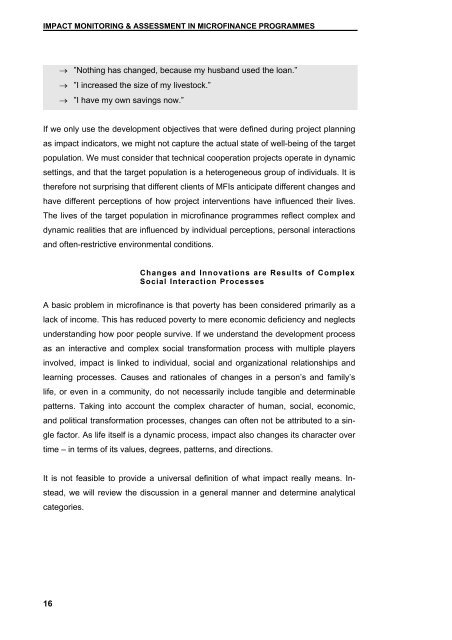Guidelines for Impact Monitoring & Assessment in Microfinance ...
Guidelines for Impact Monitoring & Assessment in Microfinance ...
Guidelines for Impact Monitoring & Assessment in Microfinance ...
You also want an ePaper? Increase the reach of your titles
YUMPU automatically turns print PDFs into web optimized ePapers that Google loves.
IMPACT MONITORING & ASSESSMENT IN MICROFINANCE PROGRAMMES<br />
16<br />
→ ”Noth<strong>in</strong>g has changed, because my husband used the loan.”<br />
→ ”I <strong>in</strong>creased the size of my livestock.”<br />
→ ”I have my own sav<strong>in</strong>gs now.”<br />
If we only use the development objectives that were def<strong>in</strong>ed dur<strong>in</strong>g project plann<strong>in</strong>g<br />
as impact <strong>in</strong>dicators, we might not capture the actual state of well-be<strong>in</strong>g of the target<br />
population. We must consider that technical cooperation projects operate <strong>in</strong> dynamic<br />
sett<strong>in</strong>gs, and that the target population is a heterogeneous group of <strong>in</strong>dividuals. It is<br />
there<strong>for</strong>e not surpris<strong>in</strong>g that different clients of MFIs anticipate different changes and<br />
have different perceptions of how project <strong>in</strong>terventions have <strong>in</strong>fluenced their lives.<br />
The lives of the target population <strong>in</strong> microf<strong>in</strong>ance programmes reflect complex and<br />
dynamic realities that are <strong>in</strong>fluenced by <strong>in</strong>dividual perceptions, personal <strong>in</strong>teractions<br />
and often-restrictive environmental conditions.<br />
Changes and Innovations are Results of Complex<br />
Social Interaction Processes<br />
A basic problem <strong>in</strong> microf<strong>in</strong>ance is that poverty has been considered primarily as a<br />
lack of <strong>in</strong>come. This has reduced poverty to mere economic deficiency and neglects<br />
understand<strong>in</strong>g how poor people survive. If we understand the development process<br />
as an <strong>in</strong>teractive and complex social trans<strong>for</strong>mation process with multiple players<br />
<strong>in</strong>volved, impact is l<strong>in</strong>ked to <strong>in</strong>dividual, social and organizational relationships and<br />
learn<strong>in</strong>g processes. Causes and rationales of changes <strong>in</strong> a person’s and family’s<br />
life, or even <strong>in</strong> a community, do not necessarily <strong>in</strong>clude tangible and determ<strong>in</strong>able<br />
patterns. Tak<strong>in</strong>g <strong>in</strong>to account the complex character of human, social, economic,<br />
and political trans<strong>for</strong>mation processes, changes can often not be attributed to a s<strong>in</strong>gle<br />
factor. As life itself is a dynamic process, impact also changes its character over<br />
time – <strong>in</strong> terms of its values, degrees, patterns, and directions.<br />
It is not feasible to provide a universal def<strong>in</strong>ition of what impact really means. Instead,<br />
we will review the discussion <strong>in</strong> a general manner and determ<strong>in</strong>e analytical<br />
categories.

















![CynefinFramework final [Read-Only]](https://img.yumpu.com/19017304/1/190x135/cynefinframework-final-read-only.jpg?quality=85)